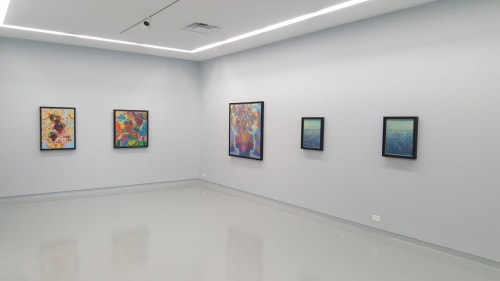Defined by civil rights struggles that came to a head with Martin Luther King Jr.’s assassination and the ensuing riots across the United States, 1968 was a pivotal if violent turning point for race relations in the country. That year, five African American artists in Chicago formed a collective that aimed to celebrate black culture and define its aesthetics and that came to be known as AfriCOBRA (African Commune of Bad Relevant Artists). As founding member Gerald Williams said in a 2011 interview for the oral history project Never the Same, the group, which is still active today, set out to investigate whether there was or should be such a thing as a culturally specific black art.
Kavi Gupta’s recent mini survey of Williams’s work comprised a dozen acrylic paintings dating from 1969 to 2017. It was the first solo show in more than twenty years for the artist, who, in 2015, after living in various places around the world (largely while serving as an arts administrator for the Air Force), returned to West Woodlawn, the South Side neighborhood where he grew up.
One of the earliest paintings on view, Say It Loud (1969), features the unifying characteristics of AfriCOBRA work: black figures, bright colors inspired by the vibrant clothes popular in the 1960s and ’70s, and text (here, the words of the title emerging from a geometric-patterned background) meant to mimic the graffiti that was ubiquitous on the walls along the “L” lines in Chicago. While employing such stylistic commonalities, each AfriCOBRA member developed his or her own approach. Williams formulated a distinctive brand of pointillism, producing dot paintings that sometimes seem to echo Indigenous art. The painter has dismissed this connection but acknowledged the influence of Paul Klee, who used dots in paintings like Sunset (1930). A quintessential example of Williams’s pointillist style is Message from a Giant—Garvey (1976/2017). In this work, representation merges with abstraction as faces and silhouettes pop out from and integrate into a multicolored patchwork whose sections are meticulously filled in with dots and circles of varying sizes. Closely related is Portrait Y (1990), which features a central masklike visage and undulating texts at the bottom. In Nostalgia (2007), Williams drops the sectionalized approach and uses the dots more amorphously to evoke a hushed, abstracted landscape in which land blurs into sky. Stylistically similar are Fragmentary Apparitions #1 and Fragmentary Apparitions #2 (both 2010), which depict ambiguous, symbolic-seeming motifs resembling totems.
In addition to receiving this solo showcase, Williams has recently participated in several important group exhibitions, including “Soul of a Nation: Art in the Age of Black Power,” at Tate Modern in London. With art historical narratives becoming more inclusive and many of the issues of the 1960s returning to the fore with movements like Black Lives Matter, this AfriCOBRA cofounder’s identity-infused imagery has lost none of its relevance.

